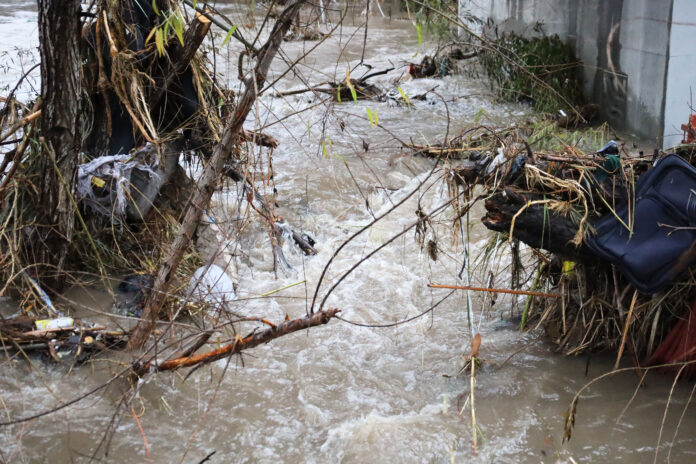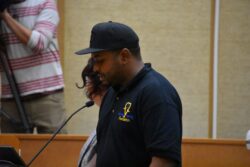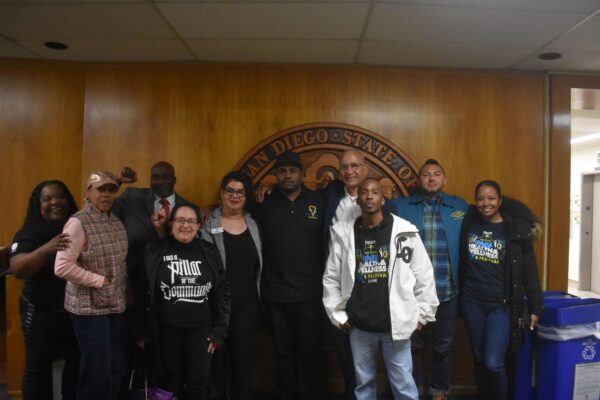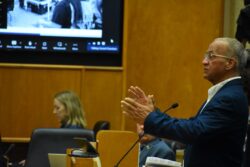
By Macy Meinhardt, Voice & Viewpoint Staff Writer
Ongoing community support and strategies for efficient disaster relief was on the hearts and minds of many Southeastern Residents Monday night as they gathered for a town hall at Jackie Robinson YMCA. The non-profit facility has served as the command center for resource distribution for the past two weeks amid the historic flood. Many flood victims accredit the Y for “saving them” when the city couldn’t; instating a division of mistrust between residents and government. However as the reality sinks in of the full scope of this storm devastation, volunteer leaders acknowledge the pressing need for the government to take over operations.
“We want to make a seamless transition and let the government be able to do their jobs,” one volunteer shared in regards to community driven operations at the YMCA shifting to centers run by the City and County.
It goes without argument that the City of San Diego storm water infrastructure has not been equipped to handle the volume of rain that has plummeted in the region. According to the Associated Press, early calculations show that “more than 150 billion gallons of water fell on San Diego County” during the first, and most damning, set of storms on Jan. 22. With people losing their homes, vehicles, belongings, and animals over this, the city has taken a lot of heat for poor storm infrastructure maintenance and slow implementation of storm relief efforts.
One YMCA staff member, who has been with the organization for ten years, shared testimony Monday night, specifically highlighting the role the YMCA played in providing her family aid in the aftermath of her home taking in two feet of water. While noting her appreciation and joy in seeing the community coming together to help, in the same breath she also expressed frustration at the City.
“I don’t think anyone would have made it without you guys,” the women said, in regards to the large group of volunteers and nonprofit organizations that united with the YMCA to help. However, “we have to keep the City accountable because it’s not fair that we always have to step up for things that they lack, for the things that they don’t do.”
To comprehend the extent of assistance offered by community-led initiatives, data collected from fifteen organizations comprising the Southeastern disaster response team over the previous ten days was presented on Monday night.
COMMUNITY ORGANIZED DATA:
- Received, sorted, and distributed over 300 individual donations, amassing a total of
2,500+ items, including bags, boxes, and large items. - Swiftly secured hotel stays for 402 residents, including 299 adults and 103 children, ensuring safe, dignified housing for up to two weeks. Residents accessed warm,
comfortable hotel rooms within 3-4 hours. - 8,100 hot meals served.
- Filled and distributed 2,000 sandbags to assist in flood prevention and protection from
subsequent storms. - Coordinated 200 volunteers and staff for tasks related to community outreach, labor, intake, housing, and referral navigation, demonstrating the collective power of
community.
“Every single day we are filling up trash trucks. Every single day from sunup to sundown we are working,” said Armon Harvey with the Harvey Foundation, on behalf of the relentless work the community has been doing in clearing out water soaked homes.

“This is life friendships forever, although it may have started ten days ago, folks used their own personal credit cards, to buy a hotel room, or a meal, or a uber to get to work, and it wasn’t this team’s responsibility,” volunteer Fred Sotelo acknowledged.
Meanwhile, according to the city they too have been deploying boots on the ground efforts to aid citizens affected by the storms under Mayor Todd Gloria’s State of Emergency. Spotlighted initiatives the City has taken is clearing out storm channels and creeks in preparation for the remainder of storms that have come this week.
Deferred maintenance over the years of flood channels such as Chollas Creek has been the source of many grievances and mistrust residents have with the city currently. According to residents who reside in these areas, they have been asking the city to clear the clogged debris out for years in fear of what ultimately ended up happening on Jan. 22.
Adding further complexity to the strain is the recognized fact that “Generations of underinvestment and injustices led to increased vulnerability in the impacted communities.” as stated in a City Staff Report.
Therefore, in efforts to perform damage control to mitigate further flooding, the city has released the following figures regarding stormwater relief efforts:
- Cleared 4 miles of channels and 22 culverts
- Cleared 73 drain systems
- Completed 8 emergency structural repair projects
- Inspected 487 storm drains
“Normally, our storm water crews are only able to clear approximately one mile of storm channels due to federal and state regulations and limited resources. Under my State of Emergency, we have been able to clear 4 miles in just two weeks,” Mayor Gloria announced via a social media post Monday, Feb. 5th.
Meanwhile, In the latest City Council Meeting on Feb. 6 Council President Sean Elo-Rivera formally recognized the Southeastern Response Team for doing the work the city couldn’t get to in time.
While “the City was very ready to respond to correcting needs with respect to infrastructure and some of the big city work that needs to get done,” Elo Rivera noted, “what we were not nearly as prepared for was to support the human needs that immediately popped up after the flooding happened.”

“And in the absence of our ability to do that, these are the folks who stepped forward along with any others to fill that gap and provide essential service,” said Council President Elo-Rivera.

While the worst of the multi-week storm system appears to be subsiding, volunteers at the meeting acknowledged that, “the truth is, we are barely at the beginning,” Sotelo stated.
The next step in the process now focuses on housing, which is the main reason why efforts are now being shifted to governmental bodies that inevitably have more resources in this department than the community, such as the San Diego Housing Commission.
In terms of community funded housing vouchers at nearby hotels, the expiration of these stays closes by the 14th. Therefore, volunteers expressed the importance of getting the data of these displaced individuals to the housing commission so the governmental body can extend their stay.
According to city statements, the City has partnered with the San Diego Housing Commission for an emergency hotel placement program. They triaged 256 households for emergency housing needs and placed 117 households (including their pets) into local hotels. Forty-one households have moved into the Ramada Inn property on Midway, and 98 households have been connected to other resources.
“Providing shelter and support for our neighbors whose lives were upended by the storm is a top priority,” Council President Elo-Rivera said. “I’m grateful to Lisa Jones and the San Diego Housing Commission for working quickly to find a housing solution for flood victims in their time of need. These creative options were possible through collaboration between the City, County, the Housing Commission and State of California. The road ahead of us is long, but this quick and meaningful action shows that we can create creative housing solutions when we all work together.”


